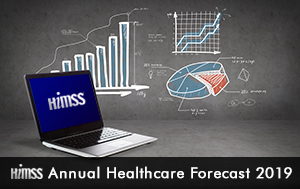HIMSS recently published its annual healthcare forecast for the year 2019. The report contains analysis and commentary from HIMSS leaders, PCHAlliance, Health 2.0 and Healthbox. The report features a birds-eye of trends and levers of change in the healthcare industry.
This annual forecast by HIMSS aims to alert healthcare leaders, experts, clinicians, EMR software solution providers, academics and policymakers, and equip them with insights to have better clinical and financial outcomes in 2019.
The complete annual report was published on Healthcare Information and Management Systems Society (HIMSS) last Wednesday and has gained the interest of healthcare industry ever since.
If you still haven’t registered for HIMSS19, then this 2 min read might change your mind Top Reasons To Attend HIMSS 2019
Top key trends in healthcare 2019
The forecast report covers the 4 key trends mentioned below:
- Digital Health Implications & Applications
- Consumer Impact
- Financial & Demographic Challenges
- Issues around Data Governance & Policy
Digital Health Implications & Applications
The report claims that digital health innovators must show greater tangible results. It also states that in 2019, digital health will have to answer how technology will enhance access to healthcare and improve point of care.
The policymakers will try to explore policy changes that will speed up the marketing of tools that increase patient access to healthcare, improve healthcare productivities, and decrease physicians’ burden. It will also create new ways for providing care that does not require long stays in hospitals.
According to the report, “Consumer pressure and the regulatory environment will be the big drivers of greater accountability. Government barriers to digital health innovation will continue to drop as the FDA Precertification (Pre-Cert) Pilot Program and CMS Innovation Center open the door to innovation.”
Consumer Impact
HIMSS 2019 report predicted that consumer pressure will accelerate global reformation and value-based care.
According to the report, “Consumer demand for greater access to personalized and patient-centered care will increasingly favor those offering convenience, choice and, most importantly, cost transparency. In 2019, external market disruptors entering the healthcare space – companies like Amazon, Google, and Walmart – will continue to apply their understanding of consumer expectations and machine learning tools to meet and exceed customer demands in ways that the traditional healthcare market still struggles with.”
Although, these mega-corporations have a sophisticated understanding of buyers’ needs and expectations they clearly lack an in-depth understanding of complexities in healthcare delivery, the report claimed. During this time of global reformation, users will increasingly ask for greater access to personalized and patient-centered healthcare services, as they move towards offering convenience, choice and cost transparency, the annual report added.
Financial & Demographic Challenges
One of the four predictions that the report listed was that the financial and demographic challenges which will lead to the formation of new procedures of healthcare delivery.
The report predicted that the companies which are focusing more on the social determinants of healthcare along with how to incorporate mechanisms for practitioners to play an important role in providing data-driven care and customized action plans will find a better accessible environment.
The report said, “Financial pressures on care providers will continue to increase as organizations are expected to do more with fewer resources and reduce costs while providing higher quality and safer care.” It also said, “The silver tsunami will continue to exacerbate these pressures, as 11,000 people per day in the U.S. reach 65 years of age. This increasing volume of patients, many with complex health issues, will compound with loud consumer demands for transparency into how increased healthcare spend translates to high quality, efficient and accessible care.”
All these demands will be met only if the healthcare systems, payers and providers advance towards a value-based healthcare delivery system in such a way that the costs are kept low for both the consumer and the industry.
Issues around Data Governance & Policy
The final prediction of the annual HIMSS 2019 report was regarding the issues around data governance and policy changes. The report says that the privacy and security of the healthcare data will be the top priority of policymakers. They will look into multiple options about policy changes to protect information that is shared between providers, patients, labs etc.
The report concluded, “In 2019, policymakers will look to the private sector and their policy counterparts in other countries to figure out what policy changes need to be put into place to protect information sharing. Consumer privacy will also gain attention in 2019. As companies adjust to privacy changes in response to the General Data Protection Regulation, consumers and policymakers will be more aware of the varying levels of data privacy protections and policies.”







